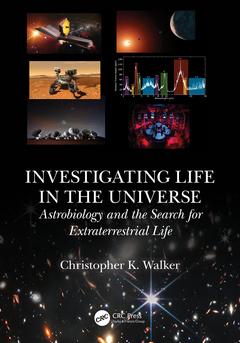Investigating Life in the Universe Astrobiology and the Search for Extraterrestrial Life
Auteur : Walker Christopher K.

This textbook gives a lively introduction to the search for extraterrestrial life. It is a guidebook to understanding the possibility of life elsewhere, pointing out landmarks and providing background information to facilitate further exploration of those areas of most interest to the reader.
We are a planet of winners ? winners of a cosmic lottery that has been in play since the universe began approximately 13.7 billion years ago. Our winnings include sentience and an underlying unease that has driven us to contemplate our place in the universe and the possibility of finding kindred spirits in the cosmos spreading out before us. To understand our origins and the possibility of life beyond Earth, we must look back and retrace the steps that have brought us to this point in space and time. In doing so, we will find the investigation of life to be a unifying theme in nature, requiring us to touch on all branches of the tree of knowledge. Using the Drake Equation as a theme, we begin with an overview of the topic and then go into the story of how we have acquired, or plan to acquire, the knowledge to solve it. As we make our journey, we will encounter some very interesting people ? some you will likely know, while others may be new to you. Keep an open mind and allow this text to be your guide.
Written in an engaging style, this textbook provides a foundational understanding of the rapidly advancing fields associated with the search for life in the universe. Each chapter includes illustrative figures and review questions for self-study. It will appeal to professionals, researchers, instructors, and undergraduate students, as well as anyone with an interest in astrophysics or astrobiology.
Preface.
Chapter 1. Drake Equation: An Overview
Chapter 2. Setting the Stage for Cosmic Discovery
Chapter 3. The Birth of Observational Astrophysics
Chapter 4. Stellar Evolution
Chapter 5. Planet Evolution
Chapter 6. The Origin of Life
Chapter 7. Evolution of Life and Intelligence
Chapter 8. Habitable Worlds
Appendix 1
Appendix 2
Appendix 3
Appendix 4
Appendix 5
Appendix 5
Professor Christopher K. Walker has over 30 years of experience designing, building, and using state-of-the-art receiver systems for terahertz astronomy. He is a Professor of Astronomy, Optical Sciences, Aerospace and Mechanical Engineering, and Applied Mathematics, and an Associate Professor of Electrical and Computer Engineering at the University of Arizona (UofA), USA. He has published numerous papers on star formation and terahertz (THz) technology. He has served as dissertation director for a number of PhD students and been a topical editor for IEEE Transactions on Terahertz Science and Technology. While working on his master’s in Electrical and Computer Engineering at the Ohio State University, he was chief engineer of the "Big Ear" radio telescope, which conducted one of the first all-sky searches for extraterrestrial intelligence (SETI). Upon completing his MS, he worked at TRW Aerospace on microwave satellite systems and then at the Jet Propulsion Laboratory (JPL) on SETI and interplanetary radar. He then earned a PhD in Astronomy from the UofA. As a Millikan Fellow in Physics at Caltech, he worked on the development of low-noise, SIS waveguide receivers above 400 GHz and explored techniques for etching waveguide out of silicon. On joining the UofA faculty in 1991, he began the Steward Observatory Radio Astronomy Lab (SORAL), which has become a world leader in developing THz receiver systems for astronomy and other remote sensing applications. Instruments developed by Walker’s team have served as primary facility instruments at the Heinrich Hertz Telescope on Mt. Graham, AZ, and the AST/RO telescope at the South Pole and have been used at the APEX telescope on the Chajnantor plateau in Chile’s Atacama region. Walker led the effort to design and build the world’s largest (64 pixels) submillimeter-wave heterodyne array receiver. He was Principal Investigator (PI) of the NASA long-duration balloon project, the Stratospheric THz Observatory
Date de parution : 11-2023
17.8x25.4 cm
Date de parution : 11-2023
17.8x25.4 cm



